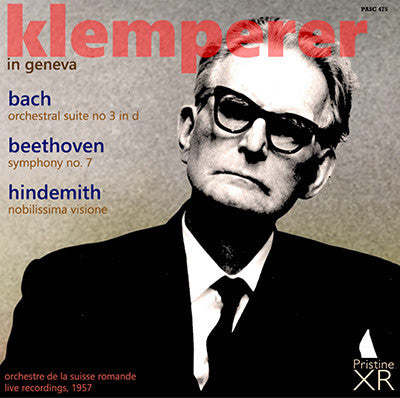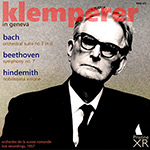
This album is included in the following sets:
This set contains the following albums:
- Producer's Note
- Full Track Listing
- Cover Art
Klemperer's incredible 1957 Geneva Beethoven 7th
"This
is quite the finest Beethoven Seventh I have heard from Klemperer ...
One surrenders to it and is swept to an overwhelming conclusion" -
MusicWeb International
Despite becoming the first principal conductor of the Philharmonia in 1959, it was in Switzerland that Klemperer settled at this stage in his life, and this live 1957 radio broadcast is a rare example of him conducting the primary orchestra of his adopted home. Recorded at Victoria Hall, Geneva, the venue for the orchestra's many Decca recordings (and thus, one might expect, well-equipped and well-known to local sound engineers), the sound quality is excellent throughout following XR remastering, which has dealt effectively with a slightly over-forward tonal balance in the original.
Alas our source material included no applause or other material from the original broadcasts, though timings would have been very tight to include any additional content for this release.
Andrew Rose
-
HINDEMITH Nobilissima Visione - Konzert-Suite (1938)
- J. S. BACH Orchestral Suite in D major, BWV1068
-
BEETHOVEN Symphony No. 7 in A major, Op. 97
Orchestre de la Suisse Romande
Otto Klemperer, conductor
Broadcast concert
Victoria Hall, Geneva, Switzerland 6 March 1957
Reviews: MusicWeb International & Fanfare
In every movement, the OSR responds magnificently, playing with great concentration and faithfully producing the conductor’s trademark granitic Beethoven textures
After his enforced exile from Nazi Germany, Otto Klemperer endured
twenty or more years of wandering before finally making his home in
Switzerland. This CD presents a ‘live’ concert with the Orchestre de la
Suisse Romande (OSR) and is a product of his residency in that country.
The performances are impressive for their ‘heroic scale’, as Peter
Heyworth characterised Klemperer’s conducting in general. His attention
to detail is accommodated within an unfailing sense of structure. The
source of this CD issue is a high-quality French FM re-broadcast of a
live recording.
Paul Hindemith was one of two composers – the
other was Igor Stravinsky – whose music helped to establish Klemperer’s
reputation as a modernist during his tenure at the Kroll Opera in Berlin
between 1927 and 1931. Nobilissima Visione was a
‘choreographic legend’ in one act and five scenes for which Hindemith
composed the music. Massine devised the choreography and danced it. The
Suite which was taken from the music is in three movements. It is
blazing and powerful – ‘visionary’ indeed – and the OSR under Klemperer
responds with whole-hearted commitment to its demands, as it does to all
the music played here.
Each of the works performed in this
concert had been recorded in the studio by Klemperer with the
Philharmonia Orchestra two or three years previously. A performance of Nobilissima Visione was probably his first recording for EMI. It was issued back-to-back with the Brahms/Haydn Variations
on a ten-inch medium play disc and was most recently reissued in a CD
boxed set of Klemperer conducting twentieth century music – review.
In comparing this performance of the Hindemith with the OSR’s, due
allowance must be made for the compromises of the ‘live’ recording
process. Perhaps understandably, the Walter Legge/Philharmonia regime at
its zenith surpasses the ‘live’ production from Geneva’s Victoria Hall –
but not by as much as you might expect.
Klemperer’s direction
varied only a little: the OSR performance is just under a minute faster.
What is noticeable is the superior balance achieved by Klemperer and
Legge in the studio. In the EMI recording, the drum which accompanies
the solo flute (probably Gareth Morris) in the second movement’s March
has a very tangible, but not exaggerated, presence – a dramatic effect
which the composer surely wanted. In the OSR production the drum is
there but is less present. In the fierce contrapuntal uproar which
prevails at the conclusion of the third movement’s Passacaglia,
the Philharmonia’s woodwinds are clearly discernible shrieking
impressively amid the din, the OSR’s less so. EMI’s clear yet
full-bodied, wide-ranging recording is, in short, a stunning example of
high-fidelity mono sound, better than many a modern effort.
For
the OSR’s performance of Bach’s Orchestral Suite No. 3, Klemperer uses
an orchestra of large if indeterminate size and there are few
concessions to ‘scholarship’. Yet what is clear from this performance
and the Philharmonia recording he made in 1954 is that Klemperer was a
Bach interpreter of formidable power, intellect and concentration. The
studio performance has somewhat more clarity and may have used a smaller
body of players and thus sounds a touch more ‘authentic’. The two
readings are very similar in outline and their total timings differ by
just one second. Listeners without ‘HIP’ prejudices, or able to suspend
them for half an hour, will be impressed by these performances.
The best is last – Beethoven’s Seventh Symphony. In assessing this
recording, my benchmark was Klemperer’s superbly recorded 1955 EMI mono
performance, not the one recorded in rather indifferent experimental
stereo at the same time. Unfortunately, it is the latter version which
has been included in the conductor’s EMI/Warner boxed set of Beethoven’s
orchestral music. The mono performance was last available on a Naxos
Historical release, coupled with the 1955 mono recording of the Fifth
Symphony. The mono Seventh received Legge’s full attention, resulting in
superb balance. Just listen to the way the timpani reinforce the climax
of the last movement and elsewhere.
The 1955 performance is
the fastest of Klemperer’s studio renditions, but this OSR example
shaves almost two minutes off it. In both readings, he maintains what
has been called his “inexorable forward momentum” without the need for
rushing. In both recordings, the conductor, as is usual for him,
exaggerates the great double hammer-blows in the first movement’s Allegro.
Rather than impeding the momentum, this reminds us that a real
conductor is in charge, not a mere time-beater. In every movement, the
OSR responds magnificently, playing with great concentration and
faithfully producing the conductor’s trademark granitic Beethoven
textures. If this is not virtuoso orchestral playing, it is something
very close to it.
In the OSR’s third movement Trio,
something occurs which I have not noticed in any other Klemperer
performance of this music: there is a delightful ‘swing’ and lilt in the
playing, achieved without the pronounced slowing down Furtwängler used
in his 1950 EMI studio recording.
I am almost certainly in a
minority in disliking ‘express train’ speeds in the final movement. My
objection is two-fold. Firstly, if the repeat is omitted - as it usually
is - a very fast tempo makes the movement sound too short in relation
to the rest of the work. Secondly, the faster the speed, the harder it
is to maintain full intensity. Furtwängler managed to bring it off in
his swift reading timed at 6:54; two seconds faster than Toscanini and
the BBC Symphony Orchestra. Walter took it even faster in his Sony
stereo recording at 6:43 and didn’t quite bring it off. It was a
slightly anti-climactic end to an otherwise great performance. Klemperer
and the OSR allow themselves 7:41. It’s true that when they start this
movement, one senses a trudge may be coming – but only for a moment.
Very soon, there is a feeling of being irresistibly drawn into a vortex
by what has been called the conductor’s “terrifying intensity”. One
surrenders to it and is swept to an overwhelming conclusion. This is
quite the finest Beethoven Seventh I have heard from Klemperer.
Pristine offers an admirable high fidelity mono recording. It
faithfully conveys the warm, full, forward sound familiar to collectors
of Ernest Ansermet’s recordings from the Victoria Hall. There is a
slight tendency for the bass to ‘boom’ on occasion, which is easily
ignored. The audience is quiet. Its applause was apparently not
preserved in the source of the recording and so is not heard here.
Rob W McKenzie
MusicWeb International
For those who enjoy pigeonholing conductors (e.g. Szell and Toscanini are always fast and taut, with a bright, lean sonority; Furtwängler is always weighty, massive, and darker in color, etc.) Otto Klemperer presents the ultimate challenge. Whether for purely musical reasons, his well-documented manic-depressive condition, or a combination of both, Klemperer can sound like different conductors at different times and places. I own recordings of Bruckner’s Fourth Symphony led by Klemperer ranging from 55:00 to 60:58, and Mahler’s Second from 73:30 to 79:43. The general perception of those who know his work mainly from his EMI Philharmonia Orchestra recordings is to think of his conducting as always on the slow and weighty side, but that is simply not true.
Pristine has made a major contribution to the Klemperer discography with this release of a complete broadcast concert by the Suisse Romande Orchestra from 1957 (with neither applause nor announcements). This same concert was released on the Archiphon label earlier; I have not heard it, but that label’s track record would not encourage me to think the quality is even close to this. The source of Pristine’s issue is a French FM radio rebroadcast, to which Pristine has added its XR processing, creating a bit more space around the orchestral sound. The result is a superb mid-1950s sound quality equal to that of professional studio recordings.
The Hindemith is perhaps the biggest surprise here to those unfamiliar with the conductor’s EMI recording of the work, to which this is similar in interpretive outline. Klemperer’s tempos in this piece are among the fastest on records. Here are a few comparisons from my own collection:
Kondrashin 19:35
Klemperer 19:40 (this performance)
Monteux 20:43
Tortelier 23:31
Muti 23:52
Hindemith 24:51
Not only is this performance quick, but it is light-footed, even witty at times. The orchestra plays very well throughout, save for a slightly askew entrance at the onset of the passacaglia finale. This is a performance of sweep and drama, with a rhythmic lift and a degree of intensity not quite present in the EMI recording.
The Bach is guaranteed to upset the HIP specialists, with its big sonority, string playing with a fairly strong vibrato, and the huge ritard prior to the work’s conclusion. Klemperer was from a generation that performed Bach regularly in a style more grand than is the norm today. He recorded the four Orchestral Suites twice for EMI, in 1954 and 1960. The performance here of the Third is freer, more spontaneously inflected, and a bit more joyous than the studio recordings, with the famous “Air” lovingly and affectionately molded.
Klemperer recorded Beethoven’s Seventh Symphony for EMI three times: in 1955, 1960, and 1968—the last being quite slow and weighty. A word often applied to this conductor, “granitic,” would fit all three recordings to varying degrees. That word is less applicable here. This performance is graceful, warmly lyrical and supple in the second movement, and the opening movement is moderately quick and very energetic. While the third and fourth movements are on the slow side, the well-sprung rhythms and an orchestral sonority somewhat lighter in texture than the studio efforts make this a more propulsive reading, and in my view an extremely successful one.
This will self-recommend to Klemperer collectors, but the more general collector may well want to seek it out as an example of one of the 20th century’s greatest conductors operating at his peak. Henry Fogel

